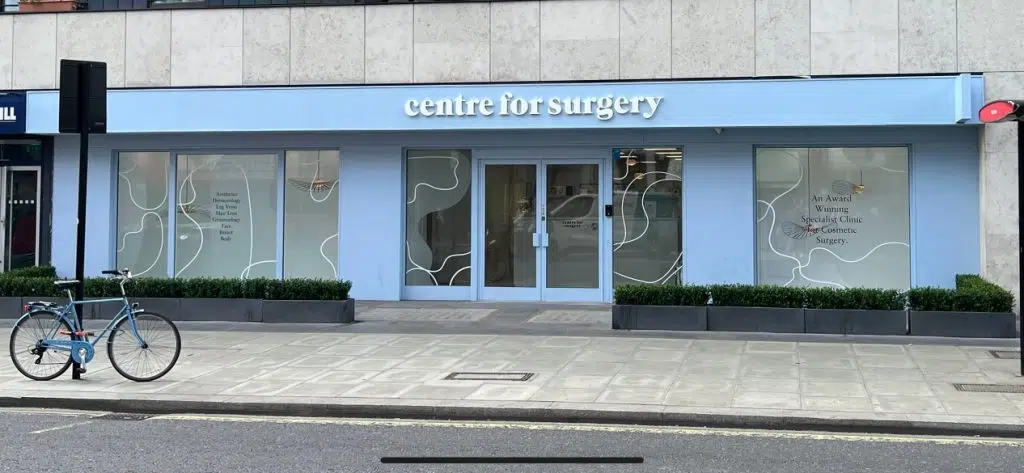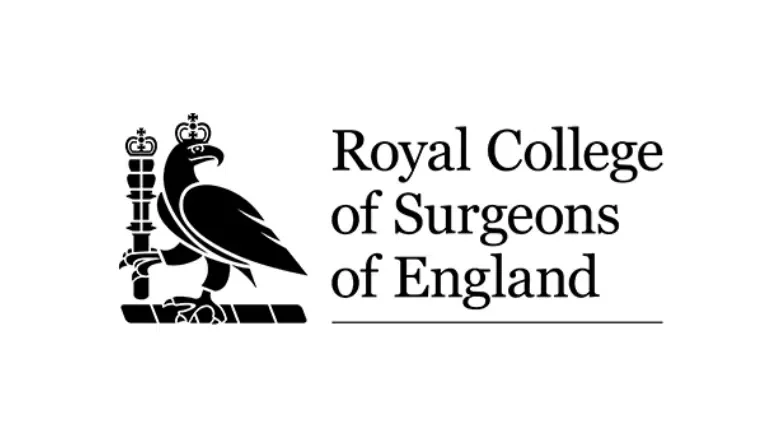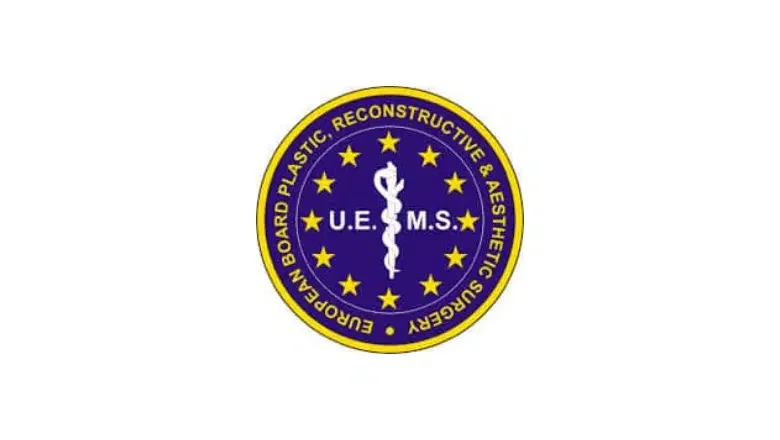Weight loss patients who have undergone bariatric surgery, such as gastric bypass (Roux-en-Y) or sleeve gastrectomy, often grapple with the aftermath of sagging, excess skin. This can make you feel dissatisfied with your body shape, despite the successful weight loss.
Body contouring surgery is a remarkable solution to this issue. Various procedures like abdominoplasty (tummy tuck), thigh lift, brachioplasty (arm lift), and mastopexy (breast lift) are meticulously designed to remove and tighten surplus skin, thereby restoring your body shape post-bariatric surgery.
However, akin to any surgical procedure, these operations are not devoid of potential post-operative complications. At Centre for Surgery, the leading specialist plastic surgery clinic in London, UK, we believe in proactive measures and patient education to mitigate these complications.
RELATED: Post-Weight Loss Surgery
Our experienced surgeons, with their in-depth medical knowledge and vast experience, are well-versed in evidence-based precautions that could significantly reduce complications from skin reduction surgery post-weight loss. This article aims to give you a deeper understanding of potential complications from post-bariatric skin removal surgery and elaborate on the precautions that can be undertaken before, during, and after your procedure to circumvent them.
What Is Post-Bariatric Body Contouring Surgery?
Post-bariatric skin reduction surgery, more commonly known as skin removal surgery, is an aesthetic procedure designed to remove surplus, lax skin that typically results from substantial weight loss.
When an individual gains weight, the skin expands to accommodate the increased fat accumulation. Over time, if the skin stretches excessively, it may lose its inherent elasticity and fail to shrink back to its original form once the weight is lost.
This physiological mechanism is the primary reason many individuals grapple with hanging flaps of sagging skin after significant weight loss achieved through diet, exercise, or bariatric surgery. Not only does this sagging skin present an aesthetic concern, but it can also lead to physical discomfort and potential skin issues.
Skin reduction surgery addresses these issues by surgically removing the loose, overstretched skin, tightening the remaining skin, and redefining the body contours post substantial weight loss.
Some of the most sought-after skin removal procedures following weight loss surgery include:
- Abdominoplasty (Tummy Tuck): Abdominoplasty is an aesthetic procedure tailored to remove drooping abdominal skin and to rectify slackened abdominal muscles that often occur following extensive weight gain and subsequent loss. This procedure aids in achieving a firmer and flatter abdominal profile.
- Mastopexy (Breast Lift): This procedure is employed to elevate drooping breasts, resulting in a perkier, fuller appearance. A breast lift achieves this transformation by removing excess skin and reshaping the remaining tissue.
- Brachioplasty (Arm Lift): Brachioplasty is a cosmetic procedure that addresses excess skin and tissue from the arms, rendering them a more streamlined and taut appearance. It’s an effective way to transform ‘bingo wings’ into beautifully contoured arms.
- Thighplasty (Thigh Lift): A thigh lift procedure is specifically designed to eradicate extra, sagging skin from the thighs. This results in a sleeker, more toned thigh silhouette, enhancing the overall lower body aesthetic.
- Lower Body Lift: This holistic cosmetic procedure is designed to eliminate surplus skin and fat from multiple areas, including the abdomen, thighs, and buttocks. The lower body lift is essentially a combination of an abdominoplasty and a thigh lift and is particularly useful for those who have experienced massive weight loss.
What Are The Potential Complications Of Post-Bariatric Skin Removal Surgery?
Skin reduction procedures, such as breast lifts, thigh lifts, or abdominoplasty, are usually performed safely under the skilled hands of a qualified and experienced plastic surgeon, such as those found at the Centre for Surgery. Expected aftereffects can include bruising, swelling, and mild discomfort during the post-operative recovery phase.
However, like all surgeries, post-bariatric skin removal procedures are not without potential complications. Here are some of the complications that patients should be aware of:
Wound Dehiscence (Wound Separation)
During the healing period after skin removal surgery, an incision may reopen, a condition known as wound dehiscence. This complication can occur after any body contouring procedure but is particularly prevalent following abdominoplasties, where extensive incisions are often required.
Wound Infection
When bacteria infiltrate the surgical wound, an infection can set in, leading to redness, pus discharge, and fever. Surgical site infection represents one of the most common complications following skin removal surgery after significant weight loss.
Skin Necrosis (Tissue Death)
If the skin surrounding the incision doesn’t receive adequate blood and oxygen, tissue necrosis can occur. The affected area can turn blue to black due to the tissue’s suffocation and subsequent death. This complication is more prevalent in smokers, as smoking impairs blood flow to the wound site.
Seromas
A seroma is a collection of serous fluid in a pocket under the skin, typically occurring near incision sites after body contouring surgery. It may present as a tender swelling or lump and can develop immediately after surgery or in the weeks following.
Haematoma
A haematoma refers to a pool of blood that accumulates under the skin, often appearing as a raised, dark bruise. While haematomas usually develop within 48 hours post-plastic surgery, they can occasionally take up to ten days to manifest.
Deep Venous Thrombosis (DVT) and Pulmonary Embolism (PE)
Blood clots can form during or post skin reduction surgery due to the prolonged period of immobility. If the clot forms within a deep vein in the calf or thigh, it’s identified as deep venous thrombosis (DVT). If the clot detaches, travels to the lungs, and obstructs a blood vessel there, it results in a potentially life-threatening condition known as a pulmonary embolism (PE).
While these complications are relatively rare, and our surgeons at Centre for Surgery do everything in their power to mitigate them, it’s essential to be informed about them prior to undergoing any surgical procedure. The key to a great outcome lies in the successful partnership between a competent surgical team and an informed patient.
Risk Factors For Complications Of Post-Bariatric Skin Reduction Surgery?
Regardless of their health status, every patient carries some risk of developing complications following skin removal surgery after substantial weight loss.
However, certain factors may elevate your chances of experiencing post-operative complications. These include:
Type of Surgical Procedure: Procedures that are time-intensive or involve the removal of a significant amount of excess tissue, such as an abdominoplasty, carry a higher risk of complications, including blood clots and wound healing issues.
Poor Post-operative Care: Insufficient attention to wound care, such as failing to maintain cleanliness and sterilisation of the surgical site, can lead to a higher likelihood of post-operative infection. The risk of haematoma and seroma formation is also heightened if compression garments are not used as advised or if surgical drains are prematurely removed.
Unresolved Health Conditions: People with existing medical conditions, such as diabetes, hypertension, heart disease, lung disease, anaemia, or coagulation disorders, carry a higher risk of complications following cosmetic surgery.
Malnutrition: Nutrients, including vitamins and proteins, play a pivotal role in wound healing and recovery. A deficiency in these nutrients can heighten the risk of wound dehiscence, infection, and skin necrosis following skin reduction surgery.
Limited Physical Activity: Many individuals restrict their physical activity post skin removal surgery due to pain, discomfort, or impaired mobility. However, reduced activity levels can increase the risk of developing blood clots and other complications.
High BMI: Individuals who have a high BMI at the time of their skin reduction surgery are more susceptible to postoperative complications. Excessive fat can hinder the flow of blood and oxygen to the incision site, impeding the healing process.
Smoking: Smoking constricts blood vessels, delaying healing, and extending recovery times. The longer it takes for your wounds to heal, the greater your risk of developing a postoperative infection.
Certain Medications: Steroids, anticoagulants, and some other drugs can exacerbate bleeding risk, inhibit wound healing, and delay recovery post-cosmetic surgery.
Older Age, Weakened Immune System, and History of Surgical Complications: All these are well-established risk factors for any surgical procedure, including skin reduction surgery.
Interestingly, studies have shown that people who undergo skin reduction surgery during the spring or summer months are more likely to encounter wound complications. This phenomenon may be attributable to a higher bacterial load at the incision site and a decline in hygiene standards during warmer seasons.
While possessing one or more of these factors doesn’t necessarily mean you will encounter a complication following your skin removal procedure, it undeniably elevates your risk. As such, understanding these factors and discussing them with your surgeon is a vital step in preparing for your post-bariatric skin reduction surgery.
RELATED: Risks and Complications of Cosmetic Surgery
Preoperative measures to minimise complications
Navigating the labyrinth of post-weight loss skin removal surgery can feel daunting. To ensure your journey is smooth and reduce potential post-operative complications, a bevy of preparatory measures should be employed.
Approach Your Ideal Weight
Having a high BMI at the time of your skin removal surgery can exacerbate your risk for complications. It is recommended that patients are at or close to their ideal weight before undertaking body-contouring surgery, as this minimises the risk of postoperative complications.
Probiotics
Following skin removal surgery, your gut flora may become imbalanced, potentially resulting in postoperative wound infections. Research suggests that pre-operative probiotic use can reduce the risk of such infections.
Maintain Excellent Hygiene
Keeping the surgical site clean in the lead-up to surgery is paramount. On the night or morning of your procedure, thoroughly cleanse your skin with an antibacterial soap. This can significantly reduce the risk of post-operative wound infections.
Blood Tests
An essential step in pre-surgical planning involves comprehensive health evaluations. Such assessments can effectively minimise the risk of complications such as bleeding, blood clots, and wound infections post-surgery.
Following bariatric procedures, patients often exhibit deficiencies in critical nutrients, including albumin, haemoglobin, Vitamins A, C, and B complex, and minerals such as iron, zinc, and selenium. These nutrients are vital for wound healing and recovery.
Through conducting pre-operative blood tests, these deficiencies can be identified and rectified. This can involve taking multivitamin supplements and treating any underlying health conditions, thereby facilitating wound healing and preventing post-operative complications.
Cease Smoking
Patients should abstain from smoking for at least six weeks prior to any body-contouring procedure. Smoking inhibits blood flow, delaying wound healing and impeding overall health. By refraining from smoking, patients can effectively reduce their risk of wound healing problems and other complications following surgery.
Limit Alcohol Consumption
Alcohol possesses the ability to thin the blood, leading to excessive bleeding during surgery. It is therefore advised that patients abstain from consuming alcohol in the days leading up to their procedure, mitigating potential complications.
Inform Your Surgeon of Medication Use
Certain over-the-counter (OTC) medications can act as blood thinners, increasing the risk of bleeding and bruising post-surgery. These include herbal supplements (Gingko, ginseng, St. John’s Wort), vitamin E, Aspirin (ibuprofen, Aleve, Motrin), and anti-inflammatory drugs (Advil). It is imperative to inform your surgeon of any medications you are currently taking so that a safe plan for discontinuation prior to surgery can be established.
Antibiotics
In certain instances, your surgeon may prescribe antibiotics prior to your procedure to prevent postoperative infections. However, it is important not to self-medicate with antibiotics unless explicitly instructed to do so by your surgeon.
Recommended precautions to minimise risks on the day of surgery
Ensuring the utmost patient safety during post-bariatric skin removal surgery is of paramount importance. There are several peri-operative precautions that can be employed by the surgical team to prevent potential complications.
Warm Surgical Environment
It’s crucial to maintain a moderate surgical environment, particularly in terms of temperature. Prolonged exposure to low temperatures (<36°C) during surgery can increase the patient’s risk of post-op bleeding and haematoma formation. Maintaining the operating room at a temperate 37°C can enhance patient outcomes and reduce the likelihood of complications following skin removal surgery.
Sterile Surgical Instruments
The use of sterile surgical instruments is a non-negotiable standard during any surgery. This practice significantly decreases the risk of postoperative complications, notably wound infections. All reusable devices used during surgery should be properly cleaned and sterilised using approved methods.
Use of PlasmaBlade for Incisions
The PlasmaBlade, or Epitome Scalpel, utilises radiofrequency (RF) energy to make precise incisions. This instrument increases surgical precision, minimises tissue damage, and reduces the risk of bleeding, seroma formation, infections, and other post-operative complications. Our surgeons use this innovative technology during all the excess skin removal surgeries.
Advanced Wound Closure Techniques
Wound closure techniques play a critical role in wound healing and the prevention of post-surgical complications. Notable advancements include the use of specialised tissue glue, interactive wound dressings, and vacuum-assisted wound closure (VAC), also known as negative pressure wound therapy (NPWT). The latter applies negative pressure to the open wound, removing fluids and promoting tissue growth. This accelerates healing and reduces the risk of surgical site infections. Special suturing techniques like the quilting technique can also lower the risk of seroma formation and wound dehiscence.
Use of Surgical Drains
During procedures such as a tummy tuck, thigh lift, or lower body lift, surgical drains may be placed near incision sites. These tubes serve to remove excess fluids and can significantly prevent post-surgical seroma formation.
Perioperative Nutritional Support
Nutritional deficiencies are common in weight loss patients post-bariatric surgery, which can affect wound healing and recovery. Providing nutritional supplementation during skin removal surgery can considerably reduce the risk of wound healing complications.
Precise Fluid Administration
Higher fluid volumes administered during surgery can increase the risk of post-operative haematomas, seromas, and wound healing complications. Precise fluid administration during surgery can help to mitigate these risks.
By incorporating these measures into practice, the surgical team can significantly improve patient outcomes and prevent potential complications during post-bariatric skin removal surgery.
Top tips to minimise risks in the postoperative period after excess skin removal surgery
Post-operative care is of utmost importance when it comes to ensuring a successful recovery after plastic surgery. Following the given instructions carefully can help reduce the risk of complications.
RELATED: Recovery After Lower Body Lift Surgery
Maintain Proper Hygiene
Good hygiene is essential to preventing wound infections post-surgery. Your surgical team will provide detailed instructions on properly caring for your wounds. Keeping your wounds clean and dry can speed up the healing process and lower the risk of complications.
Avoid Smoking
It’s crucial to avoid smoking, vaping, and exposure to second-hand smoke during your recovery period. These activities can hinder the healing process, increasing the risk of wound separation, skin necrosis, and other post-surgical complications.
Ensure Adequate Nutrition
Following your surgery, nourishing your body with healthy foods rich in proteins, vitamins, and other nutrients can expedite wound healing and reduce the chances of post-surgical complications.
Wear Compression Garments
Wearing a compression garment as your surgeon advises is vital in the healing process. It supports the wound, reduces swelling, and protects the skin surrounding your incisions. Adhering to your surgeon’s instructions regarding the use of compression garments can prevent seroma formation and promote faster healing.
Avoid Strenuous Activities
During your recovery, refrain from heavy lifting and strenuous activities. Engaging in such activities can strain your wounds and delay recovery, increasing the risk of wound breakdown, seroma formation, and infection. Ensuring sufficient rest allows your body to heal properly and recover more swiftly.
Engage in Light Physical Activities
While it’s important not to overexert yourself, light activities like walking can stimulate blood flow and help prevent the formation of blood clots. Be careful not to overdo it to avoid causing any harm to the surgical site.
Communicate Any Concerning Symptoms
If you experience symptoms such as fever, increasing pain, excessive bleeding, or other signs of complications post-surgery, contact your surgeon immediately. Early detection allows for prompt management of post-surgical complications, preventing their worsening.
While it may not be possible to eliminate the risk of complications following surgery entirely, surgeons at the Centre for Surgery take comprehensive precautions to ensure the safety and success of your body-contouring surgery. With the right post-operative care, patients can significantly reduce the risk of complications and ensure a smooth recovery.
How to manage complications of post-bariatric skin removal surgery
The occurrence of postoperative complications after post-bariatric skin reduction surgery, even when carried out by the most skilled and experienced surgeons using the latest techniques, is a potential risk. In the event that complications do arise, there are several intervention methods that surgeons can employ to manage these situations effectively.
Fluid Aspiration
If a seroma or hematoma forms after skin removal surgery, your surgeon can aspirate or drain the accumulated fluid by inserting a small plastic tube into the surgical incision. This procedure can also be used to address postoperative wound breakdown by draining the accumulation of blood, fluid, or pus that is causing the wound to reopen. In cases of wound infection, fluid aspiration can be combined with antibiotic therapy to clear the infection.
Wound Debridement
Wound debridement involves removing dead or infected tissue from the wound. This can be done using a special wound bandage, scissors, or a scalpel. It can help treat wound separation and infections following plastic surgery and speed up the wound healing process.
Antibiotic Therapy
If a wound infection occurs after post-bariatric body-contouring surgery, your surgeon will prescribe an appropriate course of antibiotic treatment to clear the bacteria causing the infection. Oral antibiotics are usually sufficient for minor infections, while more severe infections may necessitate hospitalisation and intravenous (IV) antibiotic treatment.
Vacuum-Assisted Wound Closure (VAC) Dressing Treatment
VAC is an effective treatment for wound separation following surgery. It involves using negative pressure to remove fluid and infection from a separated wound and draw the edges of the wound together, aiding in healing.
Re-closure of Wounds
In rare circumstances, it might be necessary to reclose an open wound using staples or new stitches. In the event that the wound separation is extensive, another surgery may be required to ensure the wound is adequately closed.
Management of Risk Factors
Another important aspect of managing post-surgical complications is addressing the risk factors that contributed to their development. For instance, in patients with diabetes, controlling blood glucose levels can enhance wound healing and prevent further complications.
While there is always some level of risk associated with any surgical procedure, our team of highly trained plastic surgeons at Centre for Surgery leverage their extensive knowledge, skills, and experience to take all necessary precautions, aiming to minimise the risk of complications from excess skin removal procedures following bariatric surgery.
Excess Skin Removal Surgery at Centre for Surgery
At Centre for Surgery, we understand the physical and emotional struggles that can follow massive weight loss. While you’ve made impressive strides in improving your health and well-being, the reality of excess skin can often be disheartening. Our dedicated and highly trained team is here to guide you through the final step of your weight loss journey: excess skin removal surgery.
Here’s why you should choose Centre for Surgery for your post-bariatric skin reduction procedures:
Exceptional Expertise: Our surgeons are renowned for their proficiency and are esteemed members of professional bodies such as the British Association of Plastic, Reconstructive and Aesthetic Surgeons (BAPRAS). They possess a wealth of experience in body contouring procedures and are committed to providing the highest level of care to each patient.
Patient-Centred Approach: Your journey with us begins with a comprehensive consultation where we listen to your concerns and goals, provide clear explanations about the procedures and possible outcomes, and tailor a treatment plan specifically for you. Our team will be with you every step of the way, providing postoperative support to ensure a successful recovery.
State-of-the-Art Facilities: We use cutting-edge technology and up-to-date surgical techniques at our state-of-the-art Baker Street clinic. These are designed to optimise patient comfort, surgical efficiency, and most importantly, your safety.
Emphasis on Safety: We take patient safety very seriously. Our surgeons follow best-practice guidelines and take all necessary precautions to minimise the risk of complications. Furthermore, our 24/7 aftercare team is always available to address any concerns you may have after the procedure.
Transparent Pricing: At Centre for Surgery, we believe in complete transparency with no hidden costs. Our prices are competitive, and we offer various financing options to suit your budget.
Excellent Patient Satisfaction: Our patient testimonials and high satisfaction rates attest to our commitment to excellence. We are dedicated to delivering outcomes that meet and often exceed patient expectations.
Choosing Centre for Surgery for your post-bariatric skin reduction surgery means entrusting your care to a team that values your health, well-being, and aesthetic goals above all. We are here to make your transformation journey as smooth and rewarding as possible.










